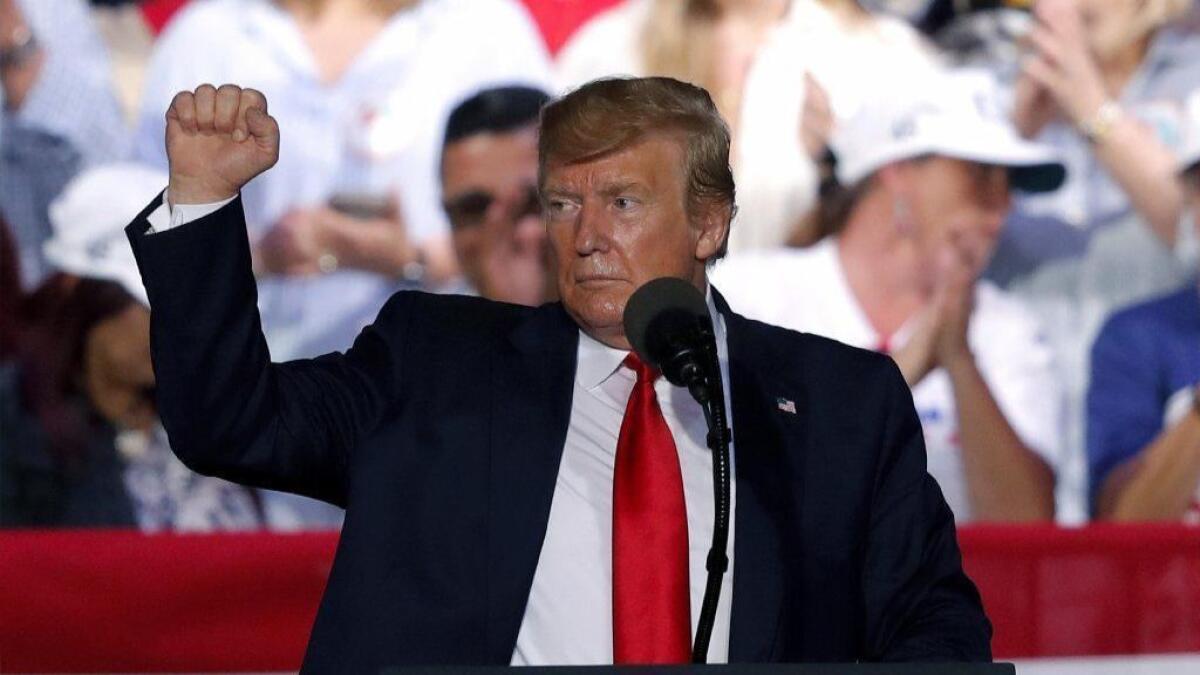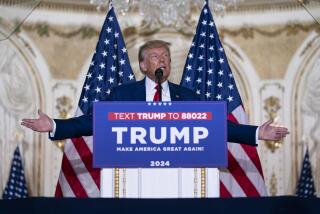Florida is key to Trump’s campaign strategy — again

- Share via
Reporting from Panama City Beach, Fla. — Democrats hoped to score major wins in Florida in 2018, with an influx of new voters from Puerto Rico fuming over President Trump’s tepid response to a ravaging hurricane and a diverse Latino population alarmed at his polarizing immigration policies.
But while Democrats won widely last November, Florida Republicans pulled off tight wins in a battleground state that’s famous for them, keeping the governorship under Republican control and flipping a Senate seat long held by a Democrat.
The victories gave Trump a powerful pair of allies for his reelection campaign as well as confidence that his attention to Florida is paying off. Although he won the White House by narrowly capturing key Rust Belt states in 2016, he has spent more time in Florida than any other state since taking office.
Democrats are increasingly nervous that their statewide losses here, and Trump’s focus on the state for 2020, have exposed a clear weakness in their efforts to drive up the Latino vote.
“Republicans were able to defy the national blue wave in Florida because they out-hustled the Florida Democratic Party and Florida Democratic candidates in getting to the Hispanic voters,” said Fernand Amandi, a Democratic pollster based in the state who specializes in Latino voting patterns.
“The Democrats make a mistake when they think they can just say the words ‘Trump’ and ‘immigration’ and think that wins the argument,” said Tim Murtaugh, Trump’s campaign communications director.
Trump is already hiring staff, collecting supporters’ cellphone numbers at his rallies and building a more sophisticated campaign operation than he had in 2016, when he eked out a 1% win over Hillary Clinton.
If Trump can keep Florida, he can overcome potential losses in Michigan, Wisconsin or Pennsylvania, where Democrats rebounded in 2018 after Clinton lost them two years earlier.
“There are lots of pathways to 270 electoral votes,” said Bill Stepien, a senior advisor to the Trump campaign. “That pathway is a whole lot easier when it includes Florida.”
Trump peppers political operatives with questions, according to a Florida Republican who speaks with him regularly at his Mar-a-Lago retreat. Which elected leaders will help him? How many voters will his Venezuelan policy attract in Miami? Has his support for Israel’s hard-right government won over Jews in strongly Democratic Broward and Palm Beach counties?
The president is expected to stage his national 2020 kickoff rally in the famed I-4 corridor, the vote-rich area along Interstate 4 that runs west-to-east between Tampa and Orlando, another signal of his priority, according to the operative.
Still, as always, Florida remains a toss-up going into the next presidential race.
“After every midterm election, there’s a debate among Florida Democrats and everybody else about whether Florida is still a purple state,” said Adam Smith, a former Tampa Bay Times political editor who now works as a communications consultant. “Election after election is decided by 1 percentage point. It’s still a battleground as much as it ever was.”
Trump believes he can expand his support with a well-funded organizing effort, and with the power of the White House bully pulpit to project success on issues that appeal to key voting segments.
John Bolton, his national security advisor, flew to Miami last month to proclaim, without proof, that the “troika of tyranny — Cuba, Venezuela and Nicaragua — is beginning to crumble.” The tough talk appeared chiefly aimed at shoring up support in the state’s conservative emigre community.
On Wednesday, Trump staged his first rally in the state since the 2018 elections, promising a boisterous crowd in Panama City Beach to deliver $448 million in disaster aid to the Panhandle region, which was heavily damaged by Hurricane Michael last October.
It was Trump’s sixth rally in Florida since he took office and 31st visit overall, although many of his visits were confined to his Mar-a-Lago golf club in Palm Beach, according to an unofficial tally kept by Mark Knoller, a White House reporter for CBS News.
During the rally, Trump boasted that he had ordered the rebuilding of Tyndall Air Force Base, a major local employer that was devastated by the October hurricane.
“There will be many more people working at Tyndall than you had the day before the storm,” Trump vowed to the cheering crowd.
But Trump also showed his potential vulnerability.
He has been unable to deliver the emergency aid because Democrats have refused to support a bill unless the White House agrees to provide more help for Puerto Rico, which Trump has resisted. During the rally, Trump blamed Democrats, falsely claiming that Puerto Rico had been awarded $91 billion in storm aid.
“And they don’t like me,” he said ruefully of Puerto Ricans, alluding to widespread anger over the botched federal response to the storm.
About a third of Florida’s Latino voters are Puerto Rican. Most live in and around Orlando, where statewide elections are often won or lost.
When Trump mused that the Border Patrol was not allowed to use deadly force against migrants, someone in the crowd shouted “Shoot them!” Trump appeared amused, not upset, saying: “That’s only in the Panhandle, you can get away with that statement. Only in the Panhandle!”
His supporters, many of whom had attended previous Trump rallies, did not appear offended.
“We’re pretty much the area who save the day” for Republicans in Florida, said Kimberly Brainerd, a 57-year-old medical technician, as she waited in line for alligator nuggets.
But Democrats insist they are not down, pointing out that they won major local races in 2018 and picked up seats in the state legislature and U.S. House.
Although more than 20 Democrats running for president are chiefly focusing on early primary states, the state party in Florida says it is registering new voters, pushing people to vote early by mail, and placing gun control ads in African American newspapers. Next month, it plans to send organizers who speak Spanish or Haitian Creole to canvass in minority communities and to better identify their concerns.
Puerto Ricans, who are citizens, are less concerned about immigration than other Latinos, for example. And Democrats will remind Venezuelan emigres that Trump, despite his efforts to topple the leftist regime in Caracas, has resisted congressional attempts to grant temporary protected immigration status for those fleeing the violence and chaos there.
Juan Peñalosa, Florida Democrats’ executive director, said the party needs to do a better job of reaching out to voters with different backgrounds and understanding their concerns.
“Republicans have been doing that,” he said. “In the past, that is not something that Democrats have done.”
More to Read
Get the L.A. Times Politics newsletter
Deeply reported insights into legislation, politics and policy from Sacramento, Washington and beyond. In your inbox three times per week.
You may occasionally receive promotional content from the Los Angeles Times.











